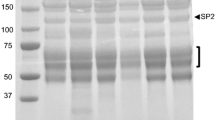Abstract
A marine thraustochytrid, Aurantiochytrium, is a promising organism to produce docosahexaenoic acid (DHA) and squalene. Utilization of inexpensive substances such as proteins in wastes and by-products from the food industry for cultivation is a considerable option to reduce production cost; however, the proteolytic ability of Aurantiochytrium spp. is low compared to taxonomically close Shizochytrium aggregatum. We previously identified extracellular protease (extracellular protease 1, EP1) in S. aggregatum ATCC 28209 from the supernatant of the culture and found that a similar protease gene (EP2) was located downstream of the EP1 gene. In the present study, we created the transformants expressing SaEP1 and/or SaEP2 to enhance the proteolytic ability of Aurantiochytrium sp. 18W-13a strain and cultivated them in the medium containing casein as a test protein substrate. Through SDS-PAGE analysis, we confirmed that casein in the supernatant was more efficiently degraded by the transformants than the wild type, suggesting that the expressed protease(s) were properly expressed and excreted. After 4-day cultivation in the casein medium, the value of optical density at 660 nm and the cell number in the culture of the transformant that expressed both SaEP1 and SaEP2 (designated as EP12 strain) showed 1.48- and 1.38-fold higher than those of wild type, respectively. The DHA and squalene yield of the EP12 strain were respectively 158.3 and 0.23 mg L−1, and these values were 1.42- and 2.01-fold higher than those of wild type, respectively, suggesting that the EP12 created in the present study is a favorable strain for the cultivation using protein-containing medium.





Similar content being viewed by others
Data Availability
All data generated or analyzed during this study are included in this published article and its supplementary information files.
References
Aasen IM, Ertesvåg H, Heggeset TMB, Liu B, Brautaset T, Vadstein O, Ellingsen TE (2016) Thraustochytrids as production organisms for docosahexaenoic acid (DHA), squalene, and carotenoids. Appl Microbiol Biotechnol 100:4309–4321
Contreras P, Oviedo C (2023) Potential and future perspectives of thraustochytrids in bioremediation. Int J Environ Sci Technol 20:4483–4498
Gupta R, Beg QK, Lorenz P (2002) Bacterial alkaline proteases: molecular approaches and industrial applications. Appl Microbiol Biotechnol 59:15–32
Hou J, Liu W, Hu W, Chen J, Wang J, Li P, Li Y (2021) Isolation, production and optimization of endogenous alkaline protease from in-situ sludge and its evaluation as sludge hydrolysis enhancer. Water Sci Technol 83:2700–2713
Juntila DJ, Yoneda K, Suzuki I (2018) Identification of extracellular proteins from Aurantiochytrium sp. 18W–13a. J Appl Phycol 30:63–69
Juntila DJ, Yoneda K, Suzuki I (2019) Genetic modification of the thraustochytrid Aurantiochytrium sp. 18W-13a for cellobiose utilization by secretory expression of β-glucosidase from Aspergillus aculeatus. Algal Res 40:101503
Kaya K, Nakazawa A, Matsuura H, Honda D, Inouye I, Watanabe MM (2011) Thraustochytrid Aurantiochytrium sp. 18W–13a accumulates high amounts of squalene. Biosci Biotechnol Biochem 75:2246–2248
Lee GI, Shin WS, Jung SM, Kim W, Lee C, Kwon JH (2020) Effects of soybean curd wastewater on growth and DHA production in Aurantiochytrium sp. LWT 134:110245
Man CH, Shimura Y, Suzuki I (2022) Identification of extracellular proteases induced by nitrogen-limited conditions in the thraustochytrids Schizochytrium aggregatum ATCC 28209. Mar Biotechnol 24:243–254
Matrawy AA, Marey HS, Embaby AM (2023) The agro-industrial byproduct wheat bran as an inducer for alkaline protease (ALK-PR23) production by pschyrotolerant Lysinibacillus sphaericus strain AA6 EMCCN3080. Waste Biomass Valor. https://doi.org/10.1007/s12649-023-02283-5
Nakazawa A, Matsuura H, Kose R, Kato S, Honda D, Inouye I, Kaya K, Watanabe MM (2012) Optimization of culture conditions of the thraustochytrid Aurantiochytrium sp. strain 18W–13a for squalene production. Bioresour Technol 109:287–291
Park WK, Moon M, Shin SE, Cho JM, Suh WI, Chang YK, Lee B (2018) Economical DHA (docosahexaenoic acid) production from Aurantiochytrium sp. KRS101 using orange peel extract and low cost nitrogen sources. Algal Res 29:71–79
Pfaffl, (2001) A new mathematical model for relative quantification in real-time RT–PCR. Nucleic Acids Res 29:e45
Rawlings ND, Barrett AJ, Thomas PD, Huang X, Bateman A, Finn RD (2018) The MEROPS database of proteolytic enzymes, their substrates and inhibitors in 2017 and a comparison with peptidases in the PANTHER database. Nucleic Acids Res 46:D624–D632
Tani N, Yoneda K, Suzuki I (2018) The effect of thiamine on the growth and fatty acid content of Aurantiochytrium sp. Algal Res 36:57–66
Taoka Y, Nagano N, Okita Y, Izumida H, Sugimoto S, Hayashi M (2009) Extracellular enzymes produced by marine eukaryotes, Thraustochytrids. Biosci Biotechnol Biochem 73:180–182
Vazhappilly R, Chen F (1998) Heterotrophic production potential of omega-3 polyunsaturated fatty acids by microalgae and algae-like microorganisms. Bot Mar 41:553–558
Watanabe T, Sakiyama R, Iimi Y, Sekine S, Abe E, Nomura KH, Nomura K, Ishibashi Y, Okino N, Hayashi M, Ito M (2017) Regulation of TG accumulation and lipid droplet morphology by the novel TLDP1 in Aurantiochytrium limacinum F26-b. J Lipid Res 58:2334–2347
Yang T, Juntila DJ, Fujihara N, Inada T, Yoneda K, Suzuki I (2022) Enhancement of squalene production by constitutive expression of the 3-hydroxy-3-methylglutaryl-CoA reductase in Aurantiochytrium sp. 18W–13a. Mar Biotechnol 24:733–743
Acknowledgements
The authors thank Prof. Makoto M. Watanabe of Sobio Technologies Co., Ltd for providing the strain Aurantiochytrium sp. 18W-13a.
Funding
This work was supported by the JSPS KAKENHI (grant numbers JP17H00800 and 23H02344) and the JST OPERA (grant number JPMJOP1832).
Author information
Authors and Affiliations
Contributions
KY, CHM, YM, and IS contributed to the study conception and design. Material preparation, data collection, and analysis were performed by KY and CHM under the supervision of YM and IS. The first draft of the manuscript was written by KY and CHM. KY, CHM, YM, and IS participated in reviewing and editing and read and approved the final manuscript.
Corresponding author
Ethics declarations
Competing Interests
The authors declare no competing interests.
Additional information
Publisher's Note
Springer Nature remains neutral with regard to jurisdictional claims in published maps and institutional affiliations.
Supplementary Information
Below is the link to the electronic supplementary material.
Rights and permissions
Springer Nature or its licensor (e.g. a society or other partner) holds exclusive rights to this article under a publishing agreement with the author(s) or other rightsholder(s); author self-archiving of the accepted manuscript version of this article is solely governed by the terms of such publishing agreement and applicable law.
About this article
Cite this article
Yoneda, K., Man, C.H., Maeda, Y. et al. Genetic Modification of Aurantiochytrium sp. 18W-13a for Enhancement of Proteolytic Activity by Heterologous Expression of Extracellular Proteases. Mar Biotechnol (2024). https://doi.org/10.1007/s10126-023-10280-x
Received:
Accepted:
Published:
DOI: https://doi.org/10.1007/s10126-023-10280-x




